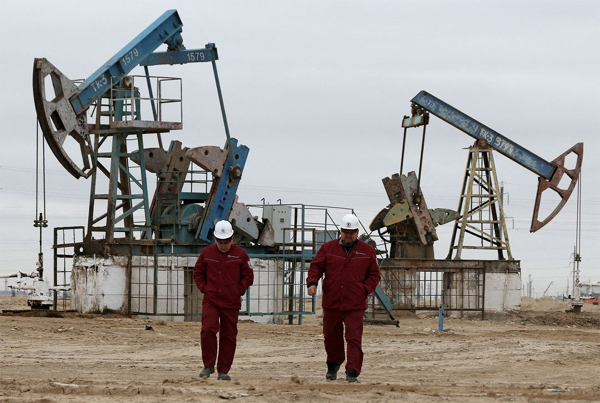
(Pavel Mikheyev/Reuters) Brent oil futures settle at highest price in more than 2 weeks
Myra P. Saefong and Williams Watts, MarketWatch
SAN FRANCISCO/NEW YORK
EnergiesNet.com 10 26 2022
Oil futures settled with a gain on Wednesday, finding support from a retreat in the U.S. dollar, following official government data showing a weekly rise in crude supplies, along with a drop in gasoline stockpiles.
Price action
- West Texas Intermediate crude for December delivery CL.1, -0.09% CL00, -0.09% CLZ22, -0.09% rose $2.59, or 3%, to settle at $87.91 a barrel on the New York Mercantile Exchange, the highest front-month contract finish since Oct. 13, according to Dow Jones Market Data.
- December Brent crude BRNZ22, 0.01%, the global benchmark, was up $2.17, or 2.3%, at $95.69 a barrel on ICE Futures Europe, the highest since Oct. 10. January Brent BRN00, -0.04% BRNF23, -0.04%, the most actively traded contract, added $2.05, or 2.2%, at $93.79 a barrel.
- Back on Nymex, November gasoline RBX22, -0.15% declined by 0.6% to $2.8994 a gallon after trading as high as $2.976, the highest intraday level since August.
- November heating oil HOX22, -0.63% was up nearly 3.9% at $4.1201 a gallon.
- November natural gas NGX22, -0.11% fell 0.1% to $5.606 per million British thermal units.
Supportive factors
The gains in oil prices Wednesday are “really about the dollar,” Phil Flynn, senior market analyst at The Price Futures Group, told MarketWatch.
Weakness in the dollar can provide a boost to dollar-denominated commodities such as oil. The ICE U.S. Dollar index DXY, 0.26% fell by 1.2% to 109.638 in Wednesday trading.
Also, at the end of the day, when you look at the EIA inventories, distillate supplies are still 20% below the five-year average and that’s “definitely giving this market a boost,” Flynn said. Distillates include heating oil, which is used during the winter heating season to heat homes.
The Energy Information Administration on Wednesday reported that U.S. crude inventories rose by 2.6 million barrels for the week ended Oct. 21, though on average, analysts had forecast a decrease of 800,000 barrels, according to a poll conducted by S&P Global Commodity Insights.
Still, the increase reported by the EIA was smaller than what was reported by industry group the American Petroleum Institute late Tuesday. The API reported a climb of 4.5 million barrels in last week’s crude stockpiles, according to a source and news reports.
The EIA data was more bullish than the API’s inventory data, and “lower gasoline inventories implies perhaps the economy, and driving, are not as weak as expected,” Michael Lynch, president of Strategic Energy & Economic Research, told MarketWatch.
The EIA data showed a weekly inventory decline of 1.5 million barrels for gasoline, while distillate stockpiles edged up by 200,000 barrels. The analyst survey had called for decreases of 1.6 million barrels for gasoline and 1.5 million barrels for distillates.
Crude stocks at the Cushing, Okla., Nymex delivery hub edged up by 700,000 barrels for the week, the EIA said, while crude stocks in the Strategic Petroleum Reserve fell by 3.4 million barrels.
Other market drivers
Analysts also weighed remarks Tuesday by Prince Abdulaziz bin Salman, Saudi Arabia’s energy minister. Speaking at a conference in Riyadh, Prince Abdulaziz defended the OPEC+ decision to cut oil production by 2 million barrels a day and warned that the depletion of strategic crude reserves by oil-consuming countries could cause economic pain in the months ahead.
“It is my profound duty to make it clear to the world that losing emergency stock may become painful in the months to come,” he said, after complaining that strategic reserves had been used to “manipulate markets.”
Read: Depleting strategic oil reserves could prove ‘painful in the months to come’: Saudi energy minister
President Joe Biden last week announced the release of 15 million barrels of crude from the nation’s Strategic Petroleum Reserve, the final tranche of a 180 million-barrel release announced in March. The U.S. move was coordinated with a number of other large oil-consuming nations in response to surging prices that had taken crude to roughly 14-year highs above $120 a barrel following Russia’s invasion of Ukraine.
“Given the price action since OPEC+ announced cuts, some could argue that it has helped to stabilize prices in the immediate term. However, with cuts set to last until the end of 2023, the market is expected to tighten over the course of next year,” said Warren Patterson, head of commodities strategy at ING, in a note.
marketwatch.com 10 26 2022












